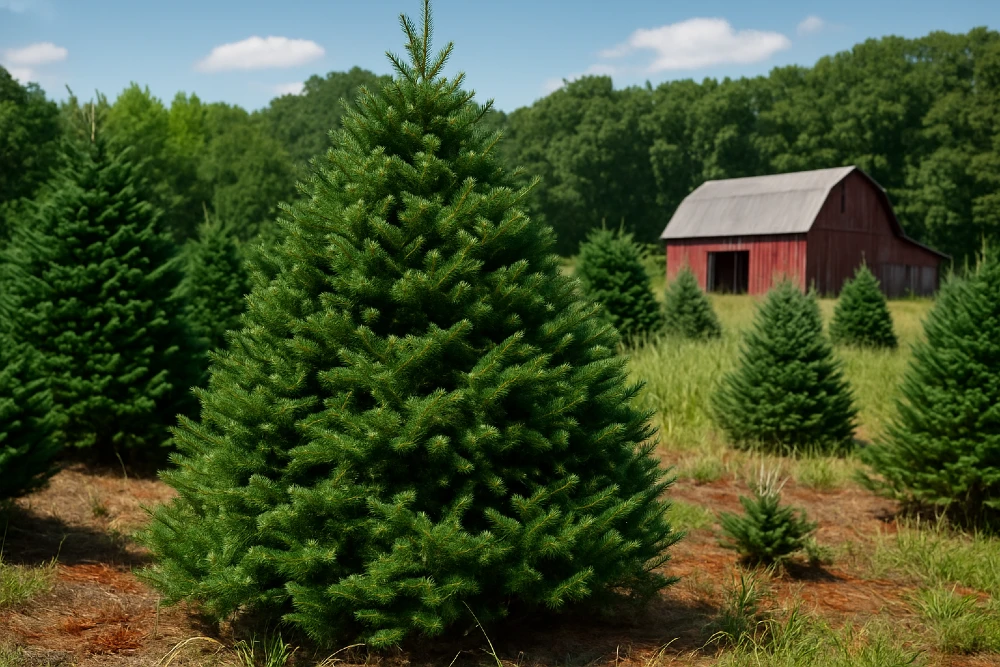Canaan Fir Christmas Tree Guide

Is the Canaan Fir a Good Christmas Tree?
If you’re trying to choose the best Christmas tree, you might wonder if the Canaan Fir is worth a spot in your living room. Known as a “hidden gem” among evergreens, the Canaan Fir combines many of the Fraser Fir’s best qualities with the adaptability of the Balsam Fir.
Pros:
- Classic conical shape with strong branches for ornaments
- Pleasant balsamic fragrance — festive but not overpowering
- Better tolerance of wetter soils than Fraser Fir
- Later budbreak, reducing risk of spring frost damage
- Good to excellent needle retention indoors
Cons:
- Needle retention can vary more than Fraser Fir
- Fragrance usually milder than Balsam Fir
- Not as widely available in some regions
Families who bring home a Canaan Fir often describe it as “the perfect balance” — soft to the touch, easy on the nose, and beautiful to decorate.
Description & Common Characteristics of the Canaan Fir
The Canaan Fir (Abies balsamea var. phanerolepis), sometimes called the West Virginia Balsam Fir, is a naturally occurring variety of the Balsam Fir, with characteristics that lean toward its close cousin, the Fraser Fir. It was first identified in the Canaan Valley of West Virginia, a high mountain plateau where cool, moist conditions helped this unique fir population thrive.
In appearance, the Canaan Fir offers everything people expect in a Christmas tree:
- Needles: Flat, soft, dark green, about ¾–1.5 inches long, with silvery undersides that shimmer under lights.
- Form: A naturally symmetrical, conical silhouette that looks like it belongs on a holiday card.
- Branches: Sturdy enough to hold heavier ornaments, yet still flexible to the touch.
When you lean close, you’ll notice its pleasant balsamic scent. It’s less intense than the Balsam Fir but fresher and sweeter than many spruces — a fragrance that gently fills a room without overwhelming it. Compared with the Grand Fir, which is famous for its very strong citrus-like aroma, the Canaan’s fragrance is more subtle and balanced. And unlike the Colorado Blue Spruce, which is admired for its striking silvery-blue color but has much sharper, pricklier needles, the Canaan offers a soft, family-friendly feel that makes decorating easier on the hands.
Needle Retention & Fragrance
How long will a Canaan Fir last indoors? With proper care, it generally performs close to Fraser Fir, keeping its needles for 3–5 weeks. Scientific trials comparing different species found that Canaan holds moisture and needles nearly as well as Fraser, though results vary depending on handling and storage.
Fragrance-wise, the Canaan Fir is a happy medium: it has the traditional “Christmas tree smell,” balsamic and woodsy, but not as pungent as the Balsam Fir. Many families appreciate this subtler scent, especially in smaller living spaces.
Where Do Canaan Fir Christmas Trees Grow?
In the wild, Canaan Fir occurs naturally in West Virginia and Virginia’s high mountain valleys, with scattered populations stretching into Pennsylvania, New York, and parts of New England and eastern Canada.
On farms, its adaptability has made it a favorite outside its native range. Unlike Fraser Fir, which struggles in heavy or wet soils, Canaan Fir can thrive in wetter, more marginal ground. This makes it popular with growers in the Midwest and Great Lakes states — Ohio, Michigan, Wisconsin, and Pennsylvania — as well as parts of Canada.
In fact, Ohio State researchers have spent decades refining Canaan Fir propagation and care, helping make it one of the region’s most reliable Christmas tree crops.
How Much Does a Canaan Fir Christmas Tree Cost?
Prices for Canaan Fir are generally comparable to Fraser Fir, though they can vary by region and farm. Expect to pay in the range of $10–$20 per foot.
- Small (4–5 ft): $40–$75
- Medium (6–7 ft): $70–$120 (most popular size)
- Large (8–10 ft): $120–$200+ depending on supply and demand
At urban retail lots, transport costs may push prices higher. Visiting a local choose-and-cut farm not only gives you a fresher tree but often saves money — plus you get the festive experience of picking your own.
How to Care for a Canaan Fir Christmas Tree
Want your Canaan Fir to last through the whole season? Follow these care tips:
- Fresh cut: Before placing in the stand, saw off ½ inch from the trunk base to open the water channels.
- Water daily: Never let the stand run dry. A tree this size can drink a gallon in the first day or two.
- Choose placement wisely: Keep it away from heating vents, fireplaces, and direct sunlight.
- Stability check: Use a sturdy stand with a wide base. Canaan Firs typically have straight trunks, making them easy to secure.
- Gentle cleanup: Expect a few needles to drop; vacuum lightly when needed.
With these steps, your Canaan Fir should hold its beauty indoors for several weeks, bringing fresh greenery and holiday cheer.
Where to Find a Canaan Fir Christmas Tree Near You
Ready to bring home a Canaan Fir this year? Their popularity is rising, especially at choose-and-cut farms in the Northeast and Midwest, but availability may still be limited compared to Fraser or Balsam.
Use our Christmas tree farms directory to find local growers offering Canaan Fir Christmas Trees. Whether you want a pre-cut option in the city or a hands-on farm adventure, our directory makes it easy to find fresh, farm-grown choices near you.